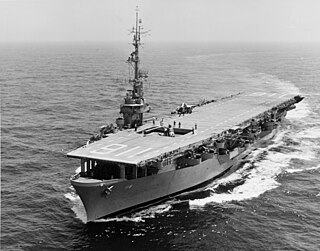
USS Badoeng Strait (CVE-116) was a Commencement Bay-class escort carrier of the United States Navy during the Korean War.
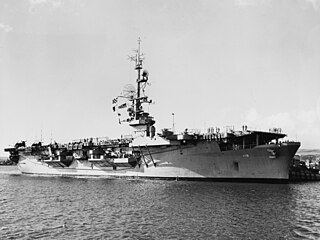
USS Bairoko (CVE-115) was a Commencement Bay-class escort carrier of the United States Navy in service from 1945 to 1955.

USS Tarawa was one of 24 Essex-class aircraft carriers built during and shortly after World War II for the United States Navy. The ship was the first US Navy ship to bear the name, and was named for the bloody 1943 Battle of Tarawa. Tarawa was commissioned in December 1945, too late to serve in World War II. After serving a short time in the Far East, it was decommissioned in 1949. She was soon recommissioned after the Korean War began, serving in the Atlantic as a replacement for carriers sent to Korea. In the early 1950s, she was redesignated an attack carrier (CVA) and then an antisubmarine warfare carrier (CVS). Except for one tour in the Far East, she spent her entire second career operating in the Atlantic and Caribbean. Consequently, Tarawa was the only ship of her class to never see combat action.
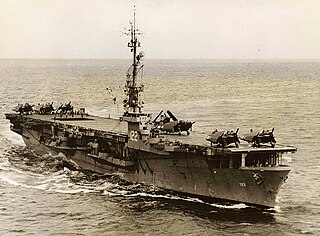
USS Palau (CVE–122) was a Commencement Bay-class escort carrier of the United States Navy.

USS Mindoro was a Commencement Bay-class escort carrier of the United States Navy. The ship was a converted oil tanker, and she had a capacity to carry up to thirty-three aircraft. She was built during World War II, but was completed too late to see action during the conflict. She nevertheless saw service with the 8th Fleet in the late 1940s and early 1950s in the Atlantic Ocean. She also made two deployments to the Mediterranean Sea, in 1950 and 1954, before being decommissioned in January 1955 and assigned to the Atlantic Reserve Fleet. She was retained for just four years before being struck from the naval register in December 1959 and thereafter scrapped.

USS Point Cruz (CVE-119) was a Commencement Bay-class escort carrier of the United States Navy. Originally named Trocadero Bay until 5 June 1944 when it was renamed after the Honiara suburb Point Cruz, which was an important location during the Guadalcanal Campaign. She was laid down on 4 December 1944 by Todd Pacific Shipyards Incorporated, Tacoma, Washington; launched on 18 May 1945, sponsored by Mrs. Earl R. DeLong; and commissioned on 16 October 1945.

USS Saidor (CVE-117) was a Commencement Bay-class escort carrier of the United States Navy.

USS Sicily (CVE-118) was a Commencement Bay-class escort carrier in the United States Navy. She was named in honor of the island of Sicily, which was the site of a major invasion during World War II. Sicily was laid down on 23 October 1944 by Todd-Pacific Shipyards, Tacoma, Washington, as Sandy Bay; launched on 14 April 1945; sponsored by Mrs. Julius Vanderwiele; renamed Sicily on 5 June 1945; and commissioned on 27 February 1946, Capt. B. W. Wright in command.

USS Commencement Bay (CVE-105), the lead ship of her class, was an escort carrier and later helicopter carrier of the United States Navy, used mostly as a training ship.

USS Block Island was a Commencement Bay-class escort carrier of the United States Navy. She was the second ship to carry her name, done in honor of the first one, being launched 12 days after the original was sunk.

USS Gilbert Islands (CVE-107) was a Commencement Bay-class escort carrier of the United States Navy.

USS Vermillion Bay (CVE-108) was a Commencement Bay-class escort carrier of the United States Navy. She was renamed Kula Gulf on 6 November 1943; laid down by Todd-Pacific Shipyards, Inc., Tacoma, Wash. on 16 December 1943; launched on 15 August 1944; sponsored by Miss Dorothy Mott; completed by Willamette Iron & Steel Corp., Portland, Oregon; and commissioned at Portland on 12 May 1945, Captain J. W. King in command.

USS Siboney (CVE-112/AKV-12) was a Commencement Bay-class escort carrier of the United States Navy. She was the second ship named for Siboney, Cuba, the Cuban Village near which troops of Theodore Roosevelt's Rough Riders fought during the Spanish–American War.
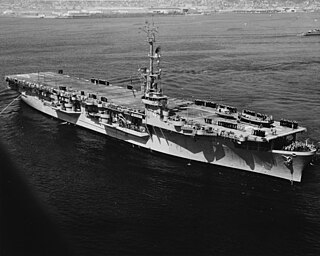
USS Rendova (CVE-114) was a Commencement Bay-class escort carrier of the United States Navy.

USS Puget Sound (CVE–113) was a Commencement Bay-class escort carrier of the United States Navy.

USS Vella Gulf (CVE-111) was a Commencement Bay-class escort carrier of the United States Navy. She was laid down as Totem Bay on 7 March 1944 at Tacoma, Washington by the Todd-Pacific Shipyards. She was renamed Vella Gulf on 26 April 1944 and launched on 19 October 1944, sponsored by Mrs. Donald F. Smith. On 9 April 1945, she was commissioned with Captain Robert W. Morse in command.

USS John W. Weeks (DD-701), an Allen M. Sumner-class destroyer, was named for John Wingate Weeks, who attained the rank of rear admiral. Weeks was elected to the United States House of Representatives where he served until entering the United States Senate in 1913. He became Secretary of War on 4 March 1921.
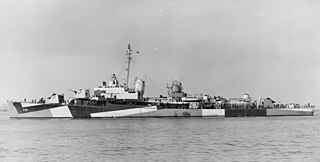
USS Willard Keith (DD-775), an Allen M. Sumner-class destroyer, is currently the only completed ship of the United States Navy ever named for Willard Keith, a United States Marine Corps captain who died in combat during the campaign for Guadalcanal. He was awarded the Navy Cross for his actions.

USS Woodson (DE-359) was a John C. Butler-class destroyer escort acquired by the United States Navy during World War II. The primary purpose of the destroyer escort was to escort and protect ships in convoy, in addition to other tasks as assigned, such as patrol or radar picket.

USS Tweedy (DE-532) was a John C. Butler-class destroyer escort in service with the United States Navy from 1944 to 1946 and from 1952 to 1969. She was sunk as a target in 1970.






















